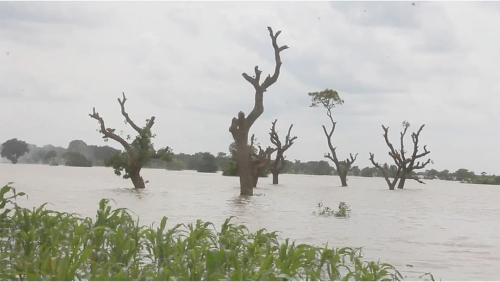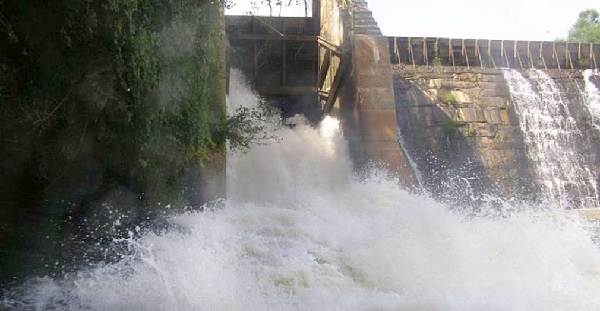
Spillage of water from the Bagre Dam in Burkina Faso has commenced. With it has come a lot of hardship on residents in the Northern, Upper West and Upper East regions who have had major roads, farmlands and property inundated by the floodwaters.
The annual spillage, which began in 1999, eight years after the construction of the multipurpose hydro dam on the White Volta, is causing havoc to many residents. While residents are still trying to come to terms with the losses they experienced in last year’s floods, another spillage was done yesterday with some residents reporting that crocodiles have invaded their homes and devoured livestock, thereby creating panic in communities affected by the floods.
To make matters worse, a prolonged rainfall in the Upper West Region has, for two weeks, brought the transportation of goods and services between the country and her northern neighbouring countries to a halt along the western corridor.
The incessant and devastating rain that resulted in floods swept away portions of the roads and damaged farmlands and houses estimated at thousands of Ghana cedis.
Since then, movements have virtually come to a standstill with many vehicles stuck and remaining parked on the roads at both ends. Classifying it as a national disaster, the government has quickly mobilised resources to the tune of GH¢50 million to start emergency works on roads that were damaged by the floods.
This has been a welcome response to put finality to the destruction caused but fears are being expressed by the inhabitants along the Black Volta River, following the announcement of the spill gates of the Bagre and Kompienga dams in Burkina Faso yesterday.

Apprehension
Although the floods, resulting from the Bagre and Kompienga dams, do not usually affect the communities in the region, there are fears that the already swollen Black Volta River that flows through some districts is going to cause more trouble to the inhabitants.
According to the inhabitants, the last time the spillage of the two dams in Burkina Faso affected the region was about three years ago but with the area overtaken by the floods and continuous rainfall, there are fears that this time round, the spillage of the dams could cause severe damage.
Farmers have, therefore, started harvesting their groundnut crops but need sunshine, while a lot of immature cereals such as maize and millet have been washed away by the floods.
According to the Director of the National Disaster Management Organisation, Mr Mustapha Ahmed, the worst affected districts are Nadowli – Kaleo, Jirapa, Daffiama/Bussie/Issa, Wa East, Wa West and Lawra.
He noted that as of now, majority of the farmers who had been left to their fate were appealing to benevolent institutions and philanthropists for assistance.
There are fears that this time round, the spillage of the two dams could cause severe damage since water levels are still rising in the region,” he said.
Ahmed advised the inhabitants, especially farmers along the Black Volta River basin who have not yet relocated, to move up land since the rains had not yet stopped and there were fears that the spillage of the dams could bring more floods.
The Pwalugu dam project, announced by the government, which is expected to provide the solution to the annual floods from the spillage of the dams, is still on the drawing board.
Residents of the flood-prone areas have urged the government to find ways and means of starting the project to bring to finality their annual predicament.
Last year’s spillage

Meanwhile, some residents living along the White Volta Lake in the Kumbungu District and Savelugu Municipality in the Northern Region are yet to recover from last year’s spillage of water
from the Bagre Dam, in addition to the torrential rain that hit parts of the region around this same period in August.
The residents, most of whom are farmers, are in the Nawuni, Afayili and Tibung communities in the Kumbungu District and Suhugtampia, Dipali, Tigla, Kukuobila, Kukuobil Tamalgu Kuldanaali, Nakpanzoo and Nabogu in the Savelugu Municipality.
Before the spillage could take place some farmlands in the affected communities had already been flooded as the level of the lake continued to rise due to heavy rainfall in parts of the region.
Some of the farmers have been forced to harvest their crops that have not yet reached their maturation stage, especially maize, to prevent them from being totally destroyed by the spillage.
The situation is also not different in the East and West Mamprusi municipalities as well as the Mamprugu Moaduri District in the North East Region and in the North Gonja District (Daboya – Mankiragu) in the Savannah Region.
Kumbungu/Savelugu
The Assemblyman for Nawuni, one of the worst affected communities in the Kumbungu District, Mr Alhassan Yussif, in an interview with the Daily Graphic said floods had already inundated farmlands in the community as a result of torrential rain that had caused the lake to rise above what was experienced last year.
We don’t know what to do now but we have asked the residents to move from their houses to a higher ground before the spillage to avoid the loss of lives and the destruction of property,” he said.
Yusssif added that last year their entire community was flooded and this time around when it happened they would move to Dalun, the next community, which was safer.
Read also: ‘Open Our Border’ Aflao residents demonstrates
Osman Dawuni, Ibrahim Shaibu, Mohammed Abubakari and Mukayali Dawuni, who are all farmers in Kukobila in the Savelugu Municipality, said their maize, rice and soybean farms were destroyed by the floodwaters last year around the same time and they were left with nothing to harvest, adding that if the same thing happened this year, it could result in hunger.
NADMO
In order to protect lives, the Director of Operations at the Northern Regional National Disaster Management Organisation (NADMO) Secretariat, Mr Abu Adams, said NADMO had intensified its sensitisation programme in the flood-prone communities in the region along the tributaries of the White Volta River, to get the residents to move to higher ground.
He stated that while some had started moving ahead of the spillage, others who had their farms along the river banks, remained adamant and that they were using traditional authorities to move those who had refused to relocate to a safer place.
The North East Regional Director of the NADMO, Mr Alhassan John Kweku, for his part, said residents living along the White Volta River in the region had heeded the call to move to higher ground to avoid last year’s experience which claimed at least 10 lives in the region as a result of the spillage coupled with torrential rainfall.
Caution

The Talensi District Director of NADMO, Mr Robert Abeero Alpha, in an interview with the Daily Graphic last Thursday also cautioned farmers and residents against wading through floodwaters to avoid being bitten by snakes or harmed by any other reptiles as their habitats might be affected.
Alpha explained that during this season, farmers and other residents usually complained of creeping reptiles such as snakes causing havoc in some communities.
He, therefore, advised them to quickly harvest their farm produce before the impact of the spillage was felt in their respective communities.
At the moment, we are giving the farmers along the White Volta River the early warnings; if you have your crops that are mature you have to harvest them now and when you harvest the crops don’t leave them there on the farms, carry them home,” he stated.
He said he had also been sensitising the residents not to approach floodwaters alone “because should you go there alone no one would be there to rescue you.”
Disaster volunteer groups, zonal disaster officers and rapid response team members are all over the communities to educate people on how best to take precautionary measures,” he added.
Crocodile controversy
In a related development, there are reports of crocodiles creeping into people’s homes to cause havoc in the Tempane District.
The Member of Parliament for the area, Miss Lydia Lamisi Akanvariba, said she had received complaints from some residents that crocodiles, snakes and all manner of reptiles had crept into some houses to devour some domestic animals and to cause havoc.
She stated this when she and some NADMO officials toured some communities affected by the floods.
We have an instance where a crocodile entered somebody’s house and devoured some animals; if it were to be human beings what would we have done?” she asked.
The MP, therefore, entreated NADMO and other relevant institutions to go to the rescue of residents, mentioning, in particular, the need for engineers and the government to take a second look at the Tamne Dam being constructed in the Garu District.
Tamne Dam
The District Chief Executive for Tempane, Mr Paul Azumah Abugri, however indicated that he was not aware of crocodiles creeping into houses to cause problems. He noted that the major challenge facing the people was the fact that as a result of the construction of the Tamne Dam, located in the nearby Garu District, water from the reservoir of the dam had submerged the Gagbiri-Garu stretch of the road.
He explained that the road was the shortest route linking the Gagbiri community to Garu and assured the people that the government would do something about the situation.
Abugri said some of the farmlands and crops belonging to some farmers had also been submerged which he was aware of.
But as far as I am concerned I have not seen any crocodile yet. But I must say that these snakes and crocodiles are all part of the ecosystem and we have brought in officials from the Ghana Irrigation Development Authority who have confirmed to us that there is no way water from the Tamne reservoir could get into people’s houses,” Mr Abugri further stressed.

